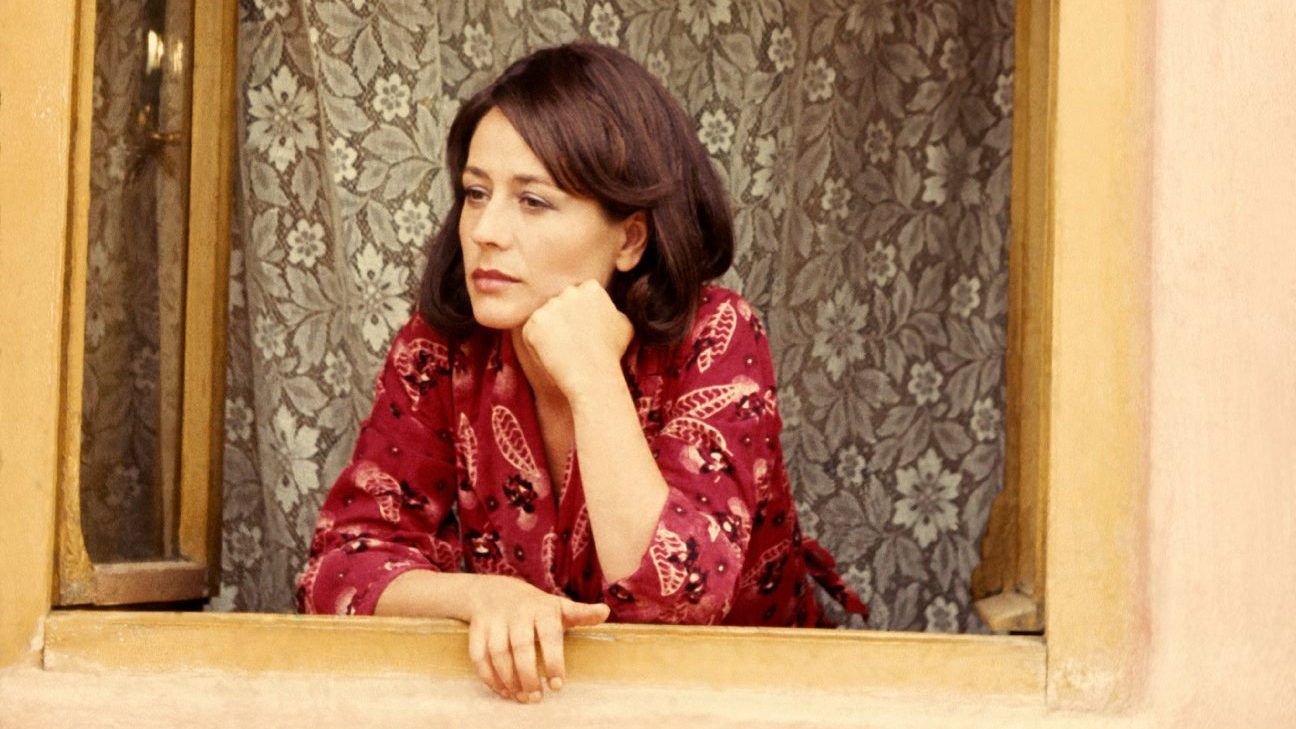“At first sometimes it’s the name of a movie, for example, that you can’t remember any more. Or the name of a city. I am in London, but I’m sure it’s Berlin.”
Annie Girardot’s face fills the screen. Pausing between each phrase she looks to the right, then to the left, then down, frowning slightly. It’s the spring of 2007 and she’s 75 years old. Girardot has appeared in 150 films and is one of France’s most beloved actors, playing a string of unforgettable, wronged but formidable women and winning three Césars, two Molière awards and a best actress gong at the Venice film festival for 1965’s Trois chambres á Manhattan.
This role is different, though. Certainly her most challenging. There’s nowhere to hide here, even if she wanted to. With her face framed this
tightly every line, every wrinkle is visible, every movement tangible down
to the slightest twitch. It’s an intense examination of a human face. There is a whole life on display here, every line part of a story, and for French cinemagoers it’s a face they know almost as well as their own.
That’s the intention. Every blemish, every mark, every aspect of this face
needs the immortality of this particular preservation. And the words. These are possibly the most important words she’ll ever say and she may not be able to say them for much longer.
The face filling the screen is now playing its most challenging role. This
legend of French cinema is not in character here. This is the face of Annie
Girardot facing her own mortality.
“One day a man comes in, dressed in white. He looks solemn and he says,
‘Madame, you are ill. You are losing your memories and they will never come back’.”
In 2001 Girardot was on stage in Montevideo, appearing in Madame Marguerite as part of a Uruguayan theatre festival, a play and a role she
knew particularly well. The show was well under way when Girardot began
speaking lines from her opening scene, a scene she had already performed a
few minutes earlier. She stumbled over the words, bewildered, but with the
help of the other actors managed to make it to the end, leaving the stage in
tears. Her daughter, Giulia, was in the wings, the producers having called her a few days earlier with the news that Girardot was suffering memory lapses and behaving oddly. On her return to France she was diagnosed with
Alzheimer’s disease.
With treatment, and by initially concealing her diagnosis from all but
family and a select few industry insiders, Girardot was able to continue
acting for a few more years by having her lines fed to her through an earpiece, but even that couldn’t last forever.
In 2006 she was filming Jane Birkin’s Boxes, in which Birkin’s character
moves into an old house and finds memories appearing out of cardboard
boxes like ghosts. For one key scene the director called “action” but Girardot
remained motionless. She was being fed her lines as usual but instead of
repeating them she just stood there in silence until, after a few awkward
seconds, she frowned and asked, “Who is this talking to me?”
Within a few months, she was in a care home. In response to confusion
and rumour about her sudden disappearance from the public eye, Girardot and Giulia decided to make a television documentary following her first few months in the home, a project that made Girardot the face of Alzheimer’s disease in France.
Ainsi va la vie, “Such is Life”, brought Alzheimer’s into the popular conversation in a nation where if it hadn’t exactly been a taboo, it was a condition kept largely in the shadows. Girardot and Giulia spoke frankly about living with the condition, but it was Girardot’s message to her loved ones, addressed to the camera, that provided the most arresting moment of the film.
“The movies I made, the men I loved, it’s the beautiful story of my life,” she
said. “It’s just that you now know it better than I do.”
Girardot never attained the international reputation of contemporaries such as Brigitte Bardot and Jeanne Moreau, but in France, she was arguably more beloved than either. French cinemagoers, and women in particular, recognised something of themselves in Girardot, who always made something extraordinary out of the ordinary, making people feel they were as likely to bump into her in the supermarket as to see her on screen.
“I’ve played a judge, a lawyer, a taxi driver, a police officer, a surgeon,” she
said. “People didn’t come to watch a beautiful, vamp-like creature, simply a woman.”
Born in Paris to a single mother who worked away for long periods, Girardot
developed a strong streak of independence and a practical outlook that meant she never embraced the life of a star, regarding her career as a means to make a living rather than a lifestyle. She accepted many forgettable roles “just to pay the bills. Work, work, work, that was my life for years”.
She joined the prestigious Comédie Francaise theatrical company in the mid-1950s and made an instant impression. On seeing her performance in his La machine à écrire, Jean Cocteau declared her “the finest dramatic temperament of the postwar period”.
While she made a scattering of film appearances in France during the late 1950s, it was the Italian director Luchino Visconti who established her as a star in his 1960 Alain Delon vehicle Rocco e i suoi Fratelli. Girardot played Nadia, a prostitute caught between Delon and his brother, Simone, played
by Renato Salvatori. Salvatori’s character rapes and kills Nadia, and in filming the crucial scene Girardot received a small wound from the knife. “E per l’arte, madame,” insisted an unapologetic Salvatori, “it’s for the art, madam”. Girardot was still smitten and the couple married in 1962.
At the dawn of the 1970s, Girardot was named “woman of the year” by Paris-Match and commenced a decade of almost unbridled success, beginning with a widely praised performance in the controversial Mourir d’aimer, based on the true story of a teacher sent to prison for falling in love with a pupil who was in turn sent to a psychiatric hospital. The film smashed French box-office records.
The 1980s saw her career fade, leaving Girardot struggling financially and falling into depression and alcoholism. It was 1995 before she bounced back in an adaptation of Les Misérables, a performance for which she won her second César award.
“I don’t know if French cinema has missed me, but I have missed French
cinema madly. Madly and painfully,” she said in her acceptance speech. “Your testimony of love shows me that perhaps I am not quite dead yet.”
Another César followed for her performance in 2001’s Le Pianiste, but by then her Alzheimer’s was starting to take hold and the inevitable long, slow erasure of her memories began until that final close-up, when she allowed the camera into her most intimate thoughts and fears.
“My child, my friends, I love you. I love you and little by little I’m leaving you,” she said. “But if there’s one thing that will never disappear it will be the warmth of your love. Thank you.”




